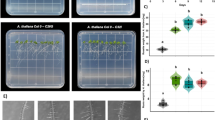Abstract
The mycobionts isolated from selected species of Haematomma (Haematomma africanum, Haematomma fenzlianum, Haematomma flourescens, Haematomma persoonii, Haematomma stevensiae) have been successfully cultured. The chemical profile of the mycobionts could be effectively influenced and modulated by varying the composition of the nutrient medium using alternative carbohydrates (glucose, sucrose, and polyols). Under artifical laboratory conditions and simulated environmental stress (exposure to UV light, desiccation, and lower temperatures) the mycobionts began producing typical secondary lichen metabolites after an incubation time of 5–6 months. Modified Lilly and Barnett medium (LBM) and Murashige Skoog Medium favoured the production of depsides such as sphaerophorin and isosphaeric acid. Surprisingly, the mycobiont from H. stevensiae in modified MS medium produced two anthraquinones in the mycelia, haematommone at the base and russulone in the upper parts of the mycelium. By contrast, the natural lichen only produced these anthraquinones in the reddish orange apothecia. The mycobiont from H. flourescens only produced the expected lichexanthone in LBM, enriched with the polyols, sorbitol and mannitol. Once the media requirements and environmental stress factors that trigger polyketide production in lichen mycobionts have been determined, it is possible to obtain a particular lichen product by a completely defined procedure. Using such knowledge, we should be able to study polyketide expression in mycobionts under optimized culture conditions for various genetic applications.




Similar content being viewed by others
References
Adler M, Fazio A, Bertoni MD, Rosso ML, Maier MS, Thell A (2004) Culture experiments and DNA verification of a mycobiont isolated from Punctelia praesignis. Bibl Lichenol 88:1–8
Aptroot A (2007) New lichens from Thailand, mainly microlichens from Chiang Mai. Fungal Divers 24:75–134
Brodo IM, Culberson WL, Culberson CF (2008) Haematomma (Lecanoraceae) in North and Central America, including the West Indies. Bryologist 111:363–423. doi:10.1639/0007-2745(2008)111[363:HLINAC]2.0.CO;2
Culberson WL (1964) A summary of the lichen genus Haematomma in North America. Bryologist 66:224–236
Culberson CF (1969) Chemical and botanical guide to lichen products. The University of North Carolina Press, North Carolina, Chapel-Hill
Culberson CF, Ammann K (1979) Standardmethode zur Dünnschichtchromatographie von Flechtensubstanzen. Herzogia 5:1–14
Culberson CF, Kristinsson HD (1969) A standardized method for the identification of lichen products. J Chromatogr A 46:85–93. doi:10.1016/S0021-9673(00)83967-9
Elix JA (1994) Additonal lichen records from Australia. 18. Haematomma saxicola R.W. Rogers from Lord Howe Island. Australas Lichenol Newsl 35:13–14
Elix JA (2004) Haematommataceae. In: Flora of Australia, vol 56A, Lichens 4. Australian Biological Resources Study, Canberra, pp 4–10
Esser K (1976) Kryptogamen: blaugalgen, algen, pilze, flechten. Springer, Berlin, Heidelberg, New York
Huneck S, Yoshimura I (1996) Identification of lichen substances. Springer, Berlin, Heidelberg
Kauffmann U, Hertweck C (2002) Biosynthese ungesättigter Fettsäuren durch Polyketid-synthasen. Angew Chem 114(11):1947–1950. doi:10.1002/1521-3757(20020603)114:11<1947:AID-ANGE1947>3.0.CO;2-1
Lilly VG, Barnett HL (1951) Physiology of the fungi. McGraw-Hill, New York, pp 10–23
Molina MC, Crespo A, Vicente C, Elix JA (2003) Differences in the composition of phenolics and fatty acids of cultured mycobiont and thallus of Physconia distorta. Plant Physiol Biochem 41:175–180. doi:10.1016/S0981-9428(02)00017-7
Nelsen MP, Lücking R, Chaves JL, Sipman HJM, Umaňa L, Navarro E (2006) A first assessment of the Ticolichen biodiversity inventory in Costa Rica: the genus Haematomma (Lecanorales: Lecanoraceae). Lichenologist 38:251–262. doi:10.1017/S0024282906005573
Rogers RW (1982) The corticolous species of Haematomma in Australia. Lichenologist 14:115–129. doi:10.1017/S0024282982000267
Staiger B, Kalb K (1995) Haematomma Studien. I. Die Flechtengattung Haematomma. II. Lichenicole Pilze auf Arten der Flechtengattung Haematomma. Bibliotheca Lichenologica 39:227
Stocker-Wörgötter E (2001) Experimental studies of the lichen symbiosis: DNA-analyses, differentiation and secondary chemistry of selected mycobionts, artificial resynthesis of two- and tripartite symbioses. Symbiosis 30:207–227
Stocker-Wörgötter E (2002) Resynthesis of photosymbiodemes. In: Kranner I, Beckett R, Varma A (eds) Protocols in lichenology: culturing, biochemistry,ecophysiology and use in biomonitoring. Springer, New York, pp 47–60
Stocker-Wörgötter E, Elix JA (2002) Secondary chemistry of cultured mycobionts: formation of a complete chemosyndrome by the lichen fungus of Lobaria spathulata. Lichenologist 34:351–359. doi:10.1006/lich.2002.0395
Yamamoto Y (1990) Studies of cell aggregates and the production of natural pigments in plant cell culture. Nippon Paint Public, Osaka
Yamamoto Y, Mizuguchi R, Takayama S, Yamada Y (1987) Effects of culture conditions on the growth of Usneaceae lichen tissue cultures. Plant Cell Physiol 28:1421–1426
Yamamoto Y, Miura Y, Higuchi M, Kinoshita Y, Yoshimura I (1993) Using lichen tissue cultures in modern biology. Bryologist 96:384–393. doi:10.2307/3243868
Acknowledgments
ESt-W. is very grateful to the Austrian Science Foundation (FWF) for financial support (P_18210 and P_20887). Tina Hametner is thanked for help with the references. ESt-W is very grateful to Dr. Chris Cargill (Curator at the lichen Herbarium, Australian National Botanical Gardens) for her generous support to do studies of Australian Lichens at ANBG during several stays in Canberra, Australia.
Author information
Authors and Affiliations
Corresponding author
Rights and permissions
About this article
Cite this article
Stocker-Wörgötter, E., Hager, A. & Elix, J.A. Intraspecific chemical variation within the crustose lichen genus Haematomma: anthraquinone production in selected cultured mycobionts as a response to stress and nutrient supply. Phytochem Rev 8, 561–569 (2009). https://doi.org/10.1007/s11101-009-9149-1
Received:
Accepted:
Published:
Issue Date:
DOI: https://doi.org/10.1007/s11101-009-9149-1




